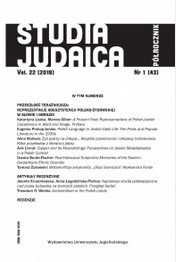Polish Language in Jewish Daily Life: The Press and Popular Literature in the 1930s
Polish Language in Jewish Daily Life: The Press and Popular Literature in the 1930s
Author(s): Eugenia Prokop-JaniecContributor(s): Grzegorz Dąbkowski (Translator)
Subject(s): Jewish studies, Media studies, Sociolinguistics, Polish Literature, Western Slavic Languages, Interwar Period (1920 - 1939), Philology, Theory of Literature
Published by: Wydawnictwo Uniwersytetu Jagiellońskiego
Keywords: Jews in Poland in the twentieth century; Jewish press in the Polish language; sensationalist Jewish dailies in the Polish language; popular Polish-Jewish literature;
Summary/Abstract: This article discusses the spread of the Polish language among the Jewish population in the 1930s. Its source is the daily press, which was one of the most important institutions of interwar Jewish culture in the Polish language and one of the key institutions in which Polish served as a means of written communication in Jewish life. The press can be regarded as one of the principle sources indicating the main modern areas of Jewish communication in Polish and documenting the expansion of this communication from the public to the private sphere, from the exchange of opinions on social, political, and artistic problems to the discussion of everyday issues, family life, or even the most intimate subjects. The Polish-Jewish popular daily press created opportunities for speaking about everyday life through journalistic and literary genres dealing with topics related to family, marriage, sex, health, fashion, cooking, housekeeping, raising children, schools and universities, sport, entertainment, etiquette. The appearance of Polish-Jewish sensationalist newspapers at the beginning of the 1930s signaled the emergence of new audiences using the Polish language. The interwar vernacularization of the Polish language manifests itself in its growing instrumental value and change in its symbolic signification. The increasingly widespread use of Polish was accompanied by the weakening of its role as a symbol of integration with Polishness and Polish culture.
Journal: Studia Judaica
- Issue Year: 22/2019
- Issue No: 43
- Page Range: 9-30
- Page Count: 22
- Language: English

